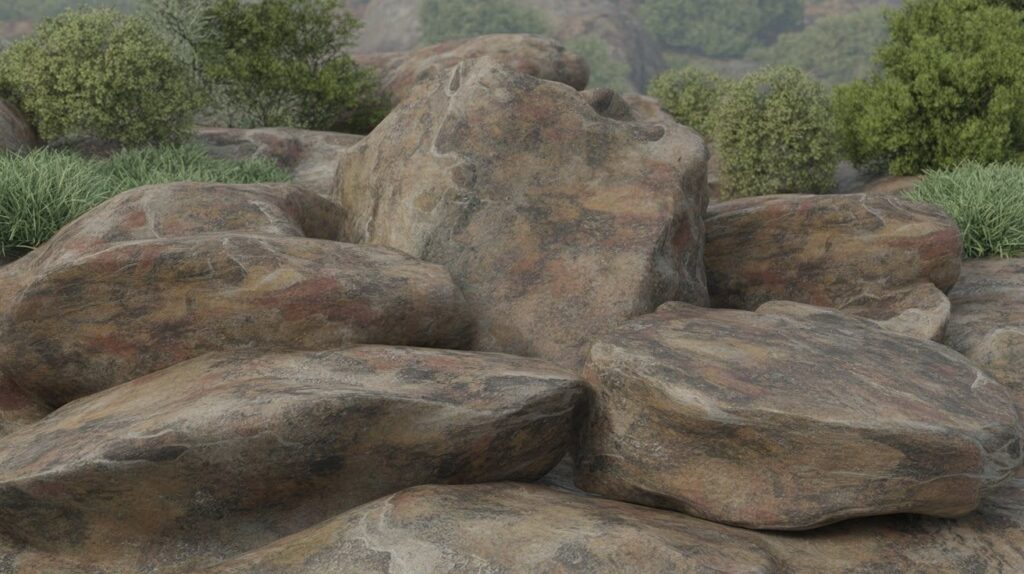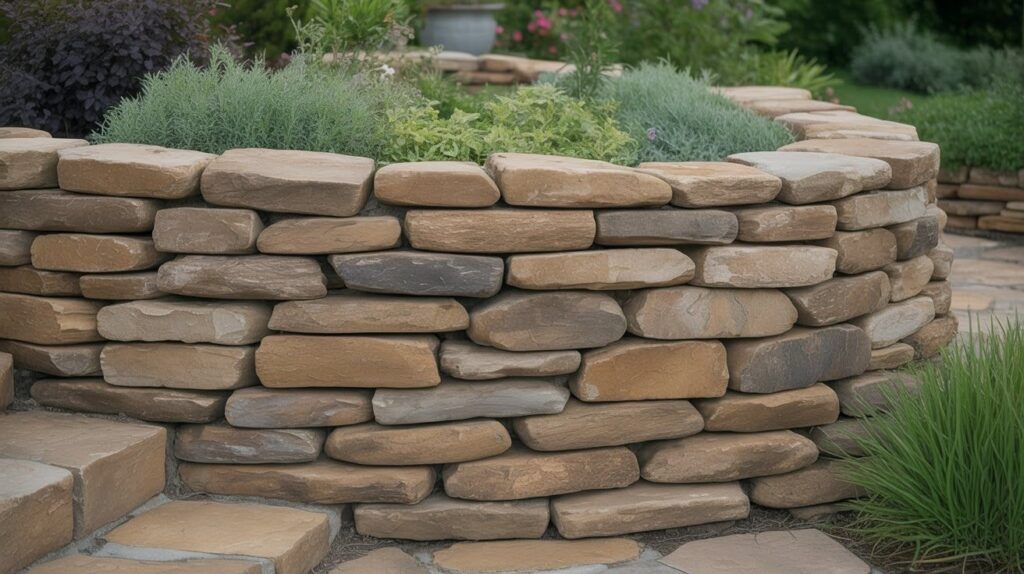Planning a boulder retaining wall but unsure about costs? I’ll help you figure it out. This guide covers everything about boulder retaining wall cost so you can budget right and avoid surprises.
I’ll show you what affects pricing, from wall size to construction methods. You’ll get real cost estimates, design ideas, and practical budgeting tips.
I’ve talked to contractors and researched current prices to give you numbers you can trust. Knowing costs upfront helps you plan confidently.
By the end, you’ll understand exactly what to expect when building your wall.
Let’s get started.
What is a Boulder Retaining Wall?

A boulder retaining wall uses large rocks over 10 inches across to hold back soil and prevent erosion. These natural stones are incredibly strong and stand up to soil pressure year after year.
The raw, uncut look gives your property a timeless feel, and each boulder is different, making your wall one of a kind.
I’ve seen these walls turn bland slopes into impressive focal points. They hold back soil on hillsides and manage tricky slopes that would otherwise wash away.
Beyond function, they add serious curb appeal. Your neighbors will notice.
The best part? These walls can last over 100 years. That’s a lifetime investment. You build it once and enjoy it forever.
Pros and Cons of Boulder Retaining Walls
Every wall type has trade-offs. Here’s what you need to know before committing.
| Pros | Cons |
| Visual appeal tops the list. Boulder walls blend into nature like they’ve always been there. They complement gardens, patios, and water features beautifully. | Space requirements are significant. Boulders are thick, so they eat up more yards than thinner concrete blocks. |
| Durability is another huge plus. Once installed correctly, these walls need very little maintenance. No painting, no sealing, no repairs for decades. | Height is limited. Boulder walls typically max out at 4 to 6 feet before you need serious engineering. Concrete walls can go higher more easily. |
| Unique design options let you stack them tight or leave gaps for plants. Create curves or keep it straight. Mix boulder sizes for texture. | Construction requires muscle. You’ll need heavy equipment to move large boulders. This isn’t a weekend DIY project for most people. |
| Cost-effective in stone-rich areas. If you live near local stone sources, costs can be surprisingly reasonable. Transportation is the killer, so local rocks save money. | Shipping costs explode if boulders aren’t available nearby. A ton of rock can cost $600 or more when hauled from far away. |
Construction Methods for Boulder Retaining Walls

Your building method affects both cost and performance. Pick the right one for your situation.
Dry-Stack (Gravity) Method:
This traditional approach relies on weight and fit. No mortar holds the rocks together. Instead, you carefully stack heavy boulders so they interlock naturally.
Water drains through the gaps between rocks. This natural drainage prevents pressure buildup behind the wall.
This method works best with heavy boulders in areas with moist soil. The weight alone keeps everything stable.
Wet-Laid (Mortar) Method:
Here you use mortar to bond the boulders together. This adds serious strength to the structure.
It works great in dry climates where drainage isn’t a constant concern. But in wet areas, you must add drainage pipes or the wall could fail.
Use Type M or Type S mortar for best results. These formulas are strong enough to handle the weight.
Combination Method:
This clever approach gives you both strength and beauty. You apply mortar at the back of the wall for stability. The front stays dry-stacked so it looks natural.
Most professional installers prefer this method. It’s the sweet spot between durability and looks.
Types of Boulders for Retaining Walls
Different boulder types change the look and cost of your wall.
Fieldstone Boulders

These rocks come straight from fields and forests. They have a weathered, aged appearance that screams authenticity.
You’ll often see moss, lichen, or dirt on the surface. This gives instant character to your wall.
Quarry Boulders

Quarry rocks are dug fresh from the ground. They have fewer sharp angles than fieldstone.
The smoother shapes make them easier to stack. Great choice if you’re tackling this as a DIY project.
River Rocks

Water has rounded these stones over thousands of years. They create a smooth, organic look.
Best for walls where you want a softer appearance. They work well near water features or in zen-style gardens.
Factors Affecting Boulder Retaining Wall Cost

Understanding these factors helps you estimate your real budget.
Size and Design
Wall length and height are the biggest cost drivers. A 50-foot wall costs way more than a 20-foot wall. Simple math.
But design complexity adds up fast. Curves, columns, built-in steps, or terraced levels require more labor and materials. Straight walls are cheapest.
Foundation and Drainage
Taller walls need deeper foundations. You can’t skip this or your wall will fail. Budget for extra excavation on walls over 3 feet.
Mortared walls might need drainage pipes installed behind them. This adds to both material and labor costs.
Labor and Equipment
Expect to pay $40 to $80 per hour for skilled labor. Some contractors charge $10 to $30 per square foot instead.
Heavy machinery isn’t optional for large boulders. Excavators or cranes add daily rental fees of $200 to $500 or more.
Material Costs
Boulder prices range from $50 to $200 per linear foot. By weight, expect $100 to $350 per ton for standard sizes.
Large specialty boulders can hit $600 per ton. The bigger and more unique the rock, the higher the price.
Extra Costs
Site prep includes clearing vegetation, leveling ground, and removing old walls. This can add $500 to $2,000.
Walls over 4 feet often need engineered plans. Engineers charge $500 to $2,000 for designs and stamped approvals.
Geogrid reinforcement stabilizes soil behind taller walls. Add $3 to $10 per square foot for this material.
Permits vary by location but typically cost $100 to $500. Drainage pipes add $5 to $15 per linear foot.
Boulder Retaining Wall Cost Estimates
Get accurate pricing for your next retaining wall project with real-world cost ranges.
| Cost Category | Price Range | Details |
| Per Square Foot | $25 – $50 | • Urban areas with high labor: upper end • Rural areas with local stone: lower end • Affected by location and boulder size |
| Per Linear Foot | $50 – $200 | • Includes labor, materials, and basic prep • Simple 2-foot walls: lower cost • Complex 4-foot walls with curves: higher cost |
| Small Walls | $1,000 – $3,000 | • Accent walls under 20 feet • Minimal prep work required |
| Typical Project | $2,000 – $10,000 | • 50-foot wall, 2-4 feet tall • Average cost: ~$6,000 • Most common residential installation |
| Large Walls | $20,000+ | • Over 100 feet in length • Complex engineering required • May need permits and drainage systems |
Boulder Retaining Wall Design Ideas
Get inspired by these popular styles that contractors are building right now.
Variegated Boulder Wall

Mix different colored stones for a natural hillside look. Use browns, grays, and tans together. The variety creates depth and visual interest.
This style mimics how nature would stack rocks on a mountainside.
Dry-Stacked Flat Boulder Wall

Stack flat boulders in a random pattern. Let them interlock organically without obvious rows. The irregular pattern looks ancient and timeless.
Perfect for rustic or cottage-style landscapes.
Mortared Boulder Wall

Combine small and large stones with visible mortar joints. This creates a sturdy, traditional look. The mortar adds a crafted feel rather than trying to hide the construction.
Great for formal gardens or historic home styles.
Boulder Wall for Seating

Use flat-topped boulders to create natural benches. Position them around patios or fire pits. Guests can sit comfortably while enjoying your outdoor space.
Function meets beauty in one structure.
Mixed Material Walls

Pair boulders with steel plates or wood timbers for a modern twist. The contrast between natural stone and industrial materials creates striking contemporary designs.
Perfect for modern homes that want natural elements.
Tips for Budgeting Your Boulder Retaining Wall
Smart planning saves thousands of dollars. Here’s how to keep costs under control.
- Get multiple quotes from at least three contractors. Prices vary wildly between companies. Compare what’s included in each estimate.
- Check local boulder availability before committing to a specific rock type. Using stones from nearby quarries cuts transportation costs dramatically.
- Budget for hidden costs like permits, drainage systems, and foundation work. These add 15 to 30 percent to your base estimate.
- Factor in design complexity when planning. Simple straight walls cost half as much per foot as curved, terraced designs. Start simple if the budget is tight.
- Consider timing your project. Some contractors offer lower rates during their slow season, typically late fall or winter.
Conclusion
Understanding boulder retaining wall cost helps you plan smart and avoid budget surprises. Most homeowners invest between two and ten thousand dollars for quality results.
I’ve always admired how these walls solve real problems while adding natural beauty to a property. The initial cost might seem high, but you’re building something that lasts generations. That’s rare these days.
Get those quotes, ask questions, and plan carefully. Your future self will thank you when you’re sitting by that beautiful wall years from now.
Got questions or your own boulder wall story? Drop a comment below. I’d love to hear from you.
Frequently Asked Questions
How much does a 50-foot boulder retaining wall cost?
A 50-foot boulder wall typically costs $2,500 to $10,000. Height, design complexity, and local material costs affect the final price.
Can I build a boulder retaining wall myself?
You can build small walls under 2 feet with proper equipment. Taller walls require professional engineering and heavy machinery for safety.
How long do boulder retaining walls last?
Boulder walls last over 100 years with proper drainage. Natural stone doesn’t rot or corrode like other materials.
Do boulder walls need drainage systems?
Dry-stacked walls drain naturally through rock gaps. Mortared walls need drainage pipes to prevent water pressure damage.
What’s cheaper: boulder walls or concrete block walls?
Concrete blocks cost $15 to $30 per square foot versus $25 to $50 for boulders. Boulder walls require less long-term maintenance.

